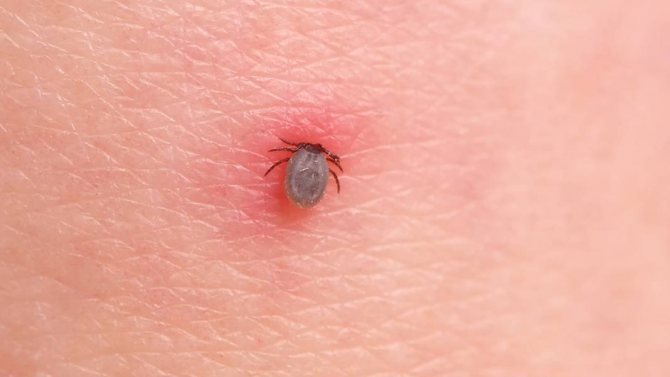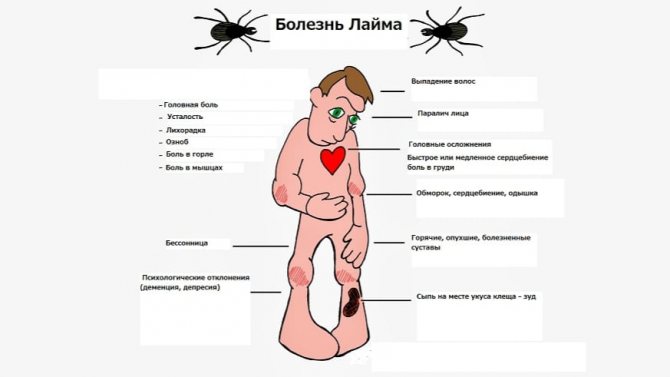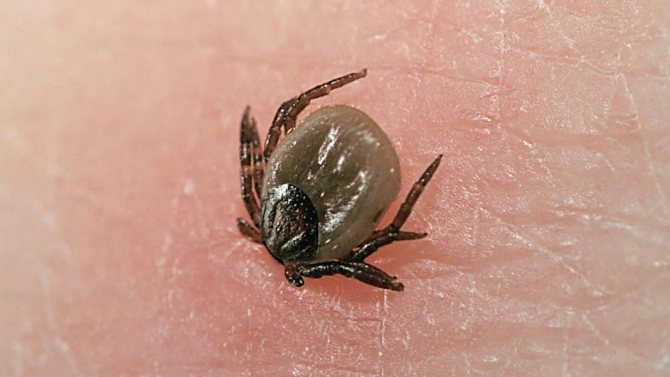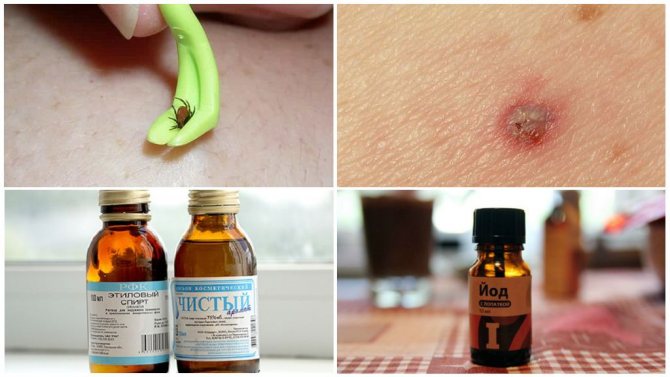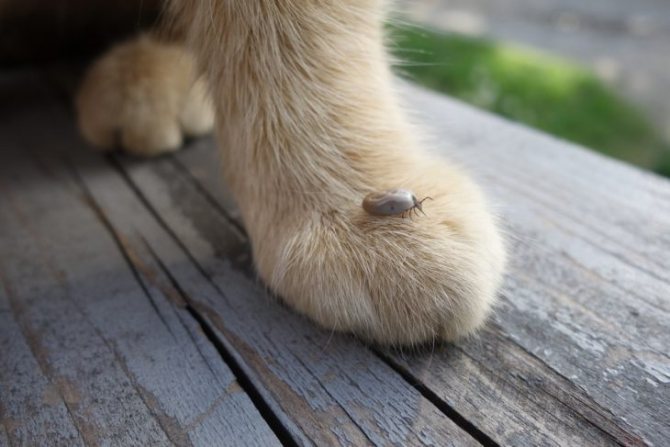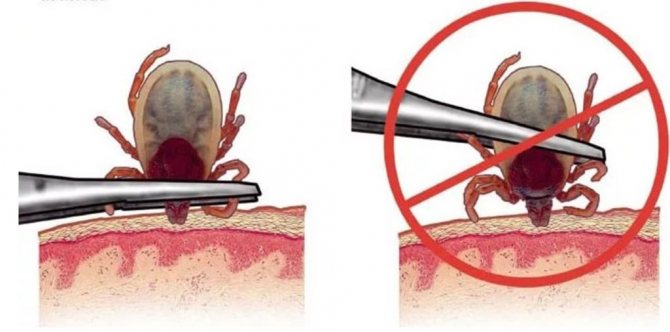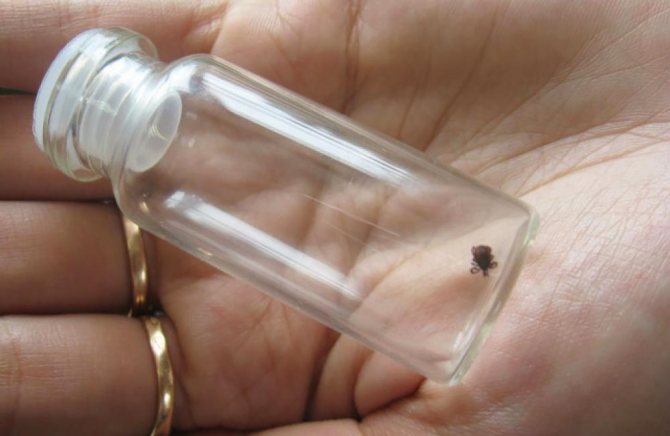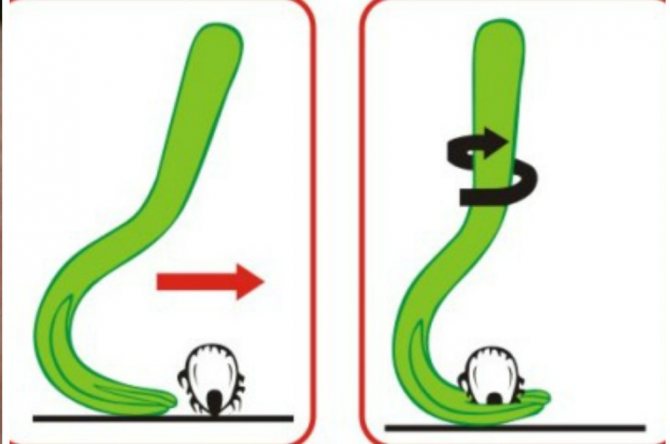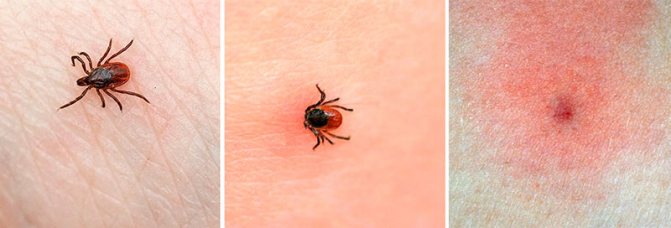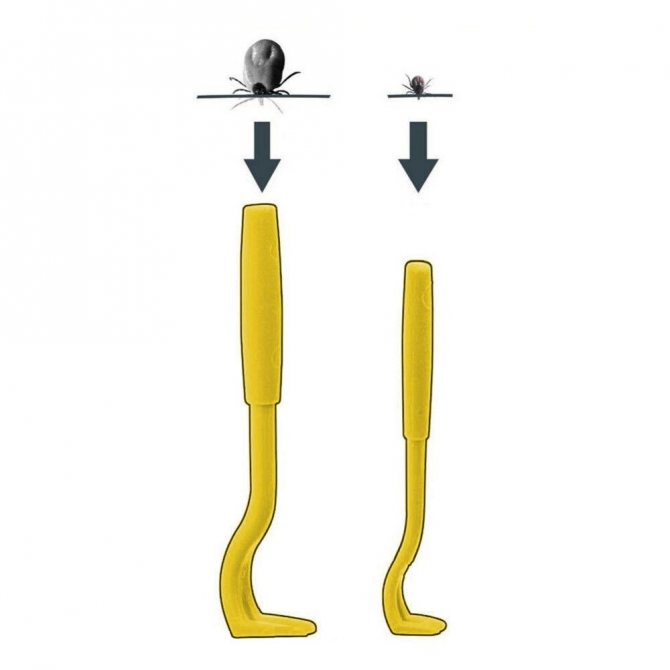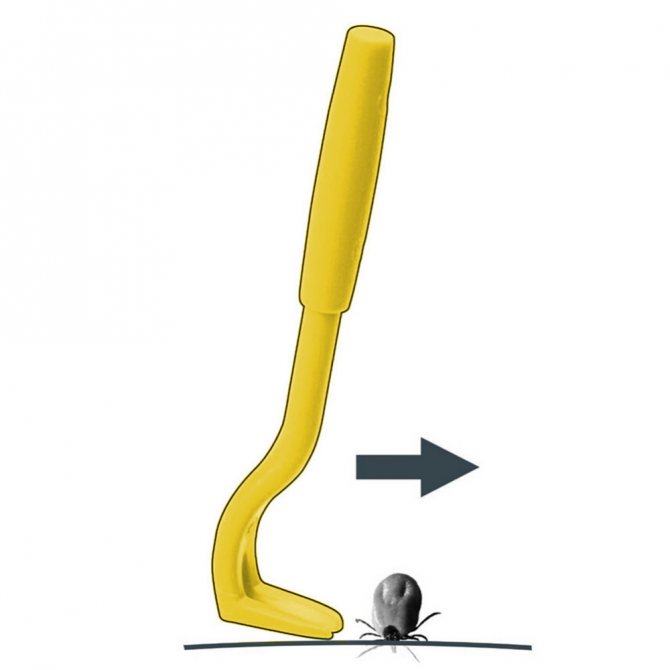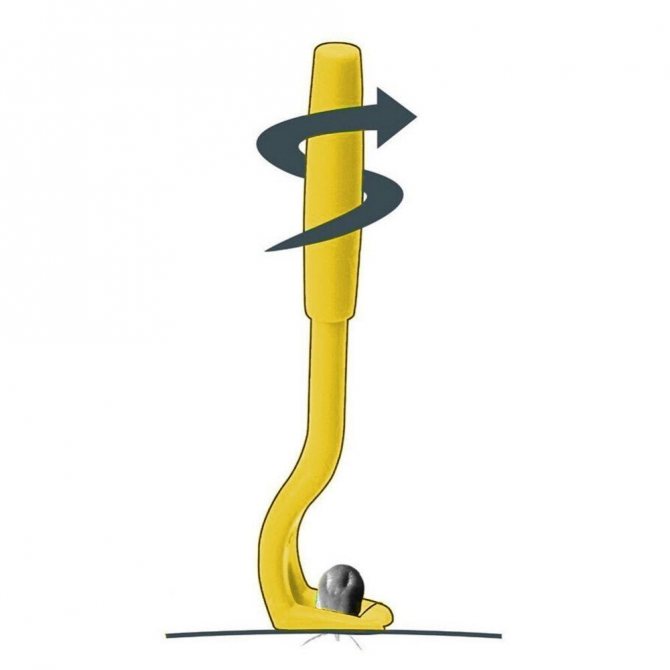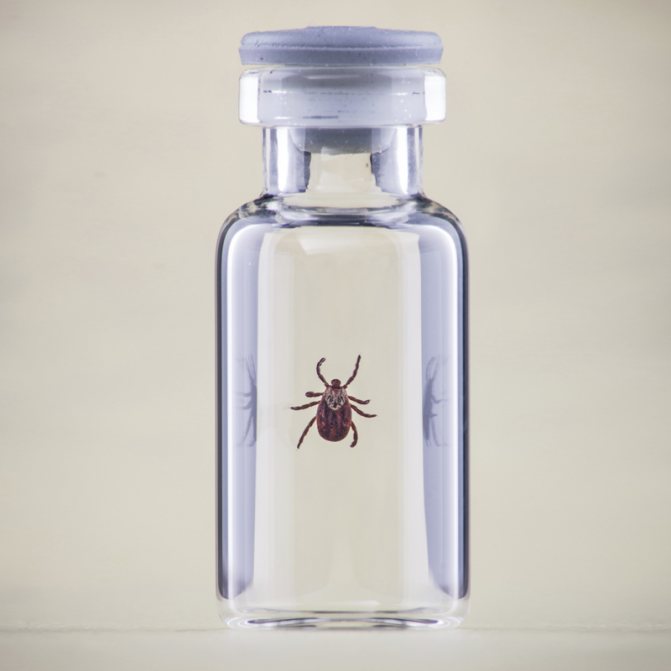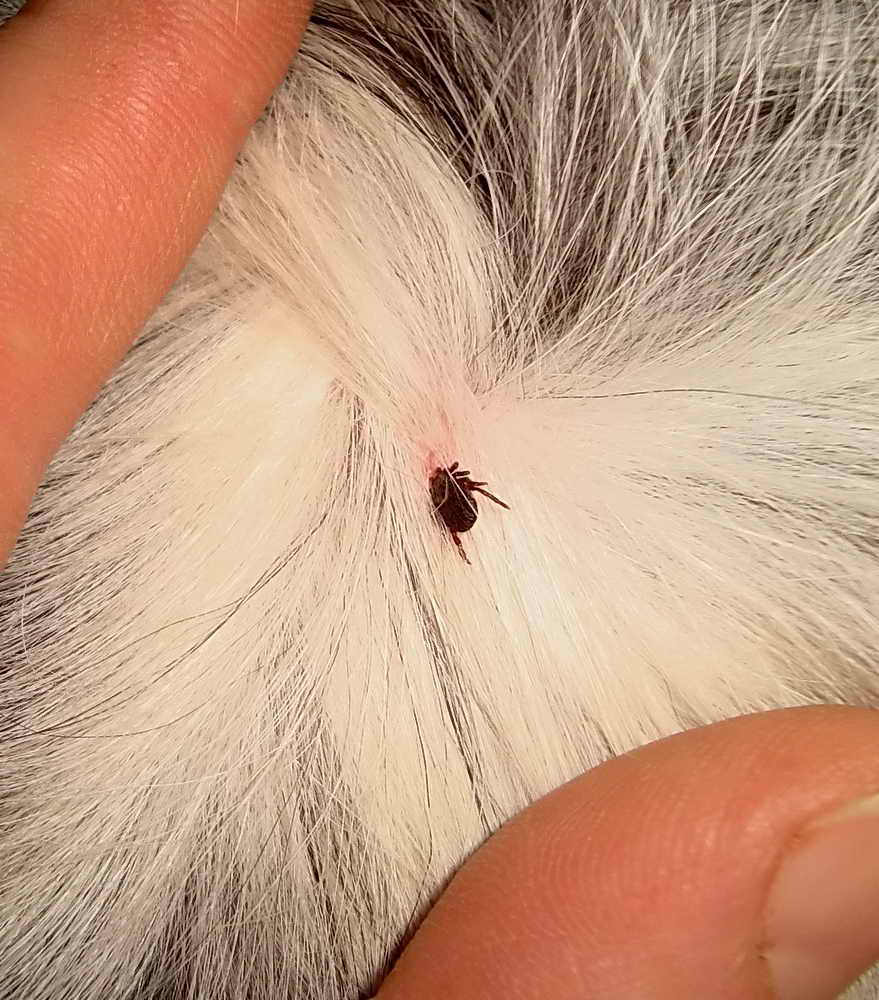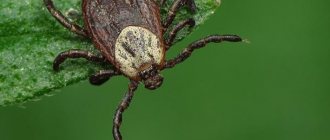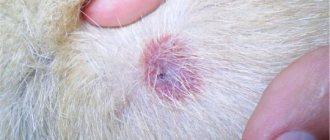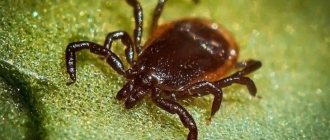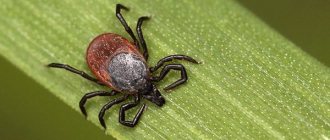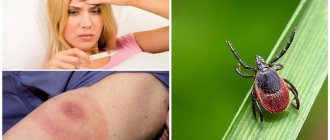A tick bite is, of course, not a pleasant event, but since it happened, then finding it in time and trying to remove it as soon as possible is half the victory and, in general, seriously reduces all the risks associated with their bites. The main thing at this stage is to avoid a situation in which the tick came off and part of it remained inside your skin!
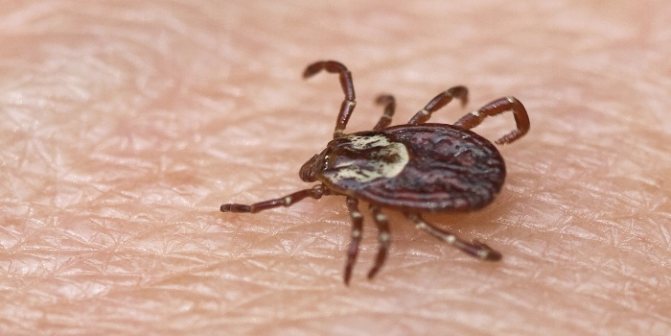
Use tweezers or a suction cup to remove the tick (it's good to have these tools in your home medicine cabinet just in case). Not always, but most often the tick can be removed independently, without medical intervention.
What you need to know about ticks
Ticks live on tree branches and in grass. Most of these insects feed on various plants and fungi. And for some of them, human or animal blood became food. It is these ticks that are dangerous, since they can easily carry dangerous viruses.
Among the infections transmitted by the parasite, the greatest danger is tick-borne encephalitis. The disease causes damage to the central nervous system and leads to persistent paresis, dementia. In addition, the tick can serve as a carrier of borreliosis, tularemia, hemorrhagic fever.
What types of blood-sucking ticks can threaten cats
All blood-sucking ticks, they are also called ixodid, or pasture, pose a threat to the cat. On the territory of Russia, the most common mites of the following species are:
- Ixodes ricinus;
- Rhipicephalus sanguineus;
- Dermacentor reticulatus.
A cat can be bitten by any other ixodid tick - there is no fundamental difference.
Photo gallery: the most common types of ticks
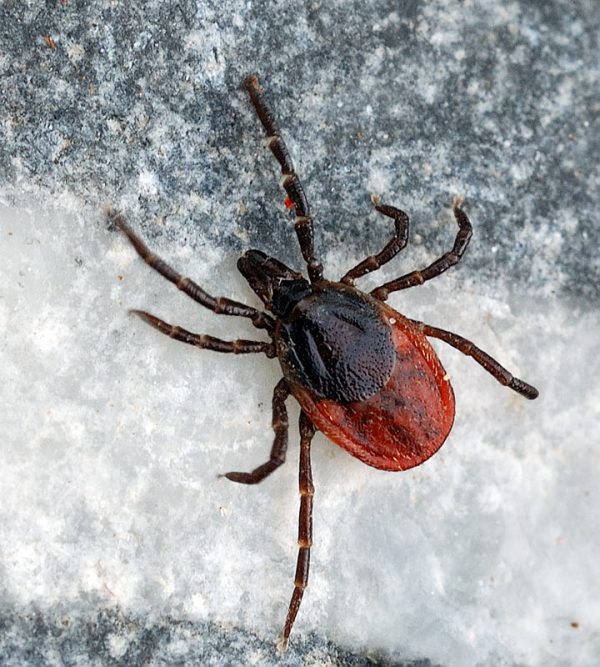

The Ixodes ricinus mite is the most common type of bloodsuckers
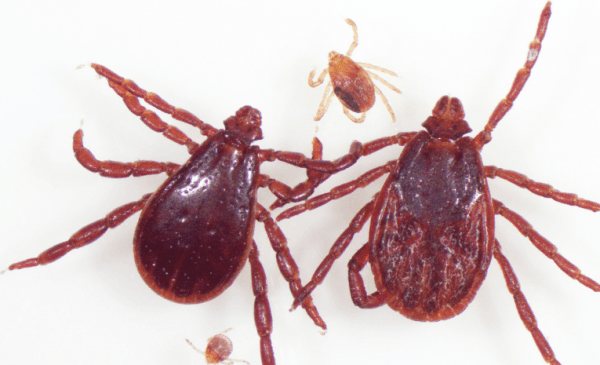

The mite of the species Rhipicephalus sanguineus is the most frequent representative of this family in Russia
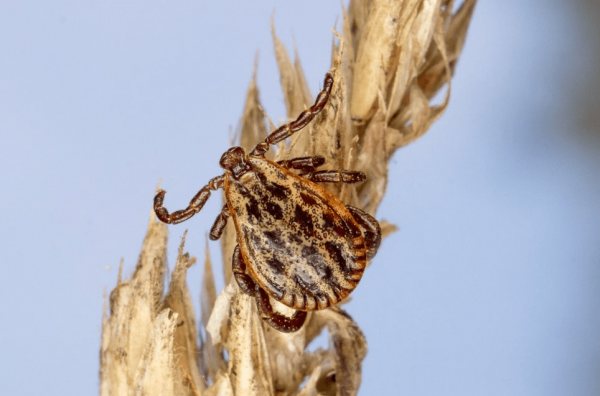

Dermacentor reticalatus mite is a typical inhabitant of deciduous and mixed forests in Europe and Siberia
All these mites have common properties: they necessarily feed on blood. Both adult sexually mature ticks and their larvae - nymphs - attack.
Usually, female ticks are found on animals - they need a lot of blood to reproduce their offspring, so they can stay at the site of the bite for up to several days. Nymphs and males need less blood, and often they leave the bite site on their own and imperceptibly, while infecting the cat.
Ticks usually hide in grass, bushes, low vegetation. They are found everywhere - from city courtyards and squares to fields and forests. Even if the cat does not leave the house, there remains the risk of being attacked by a tick brought into the apartment by people or other animals (most often a dog), as well as together with mushrooms collected in the forest, a wreath woven in the field, and herbs collected at the dacha.
Ticks are activated at an air temperature of +8 ° C, the peak of their activity occurs in spring and autumn. But the likelihood of a bite is not excluded even in winter, for example, near a heating main or during a thaw on a thawed lawn.
The good news is that not all ticks are contagious. The spectrum and frequency of diseases carried by ticks differ in different regions, and the most comprehensive information on a specific area can be obtained from the regional sanitary and epidemiological service.
If a tick is bitten: rescue methods
During the bite, the tick secretes a substance that provides an analgesic effect. Therefore, it is impossible to feel the "sucked bloodsucker". The fact that the tick has remained in the body can be found out only by one method. It is necessary to examine yourself from head to toe. Particular attention is paid to the groin area, armpits, neck, abdomen, scalp.
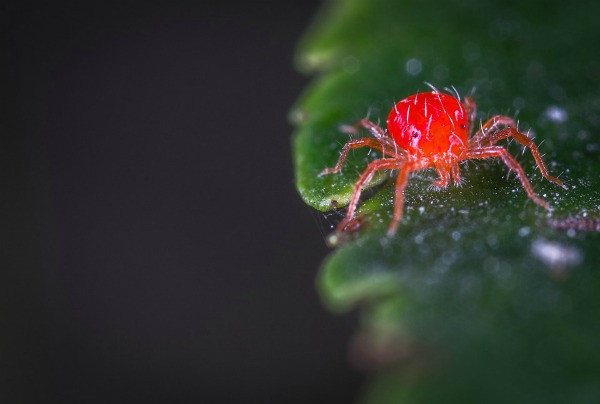

Having found a blood-sucking parasite, do not panic. It is recommended to seek medical help. Doctors will carefully remove the tick. Then they will send him for analysis. This will eliminate the risk of human infection or promptly select the necessary therapy for the victim.
Is it possible to check the removed part of the tick for infection?
This is the final question that may be of interest to those who have successfully coped with such a critical situation as a mite that is stuck under the skin. Alas, for the analysis for the encephalitis virus, a live, that is, a whole tick, is ideally needed. Not every laboratory has everything you need to work with a lost specimen, you should find out individually about your city.
If you managed to remove the tick completely, then a hermetically sealed container and a small piece of cotton wool moistened with water inside will help bring it alive to the SES.
How to draw out a tick
If a sucked insect was found in the forest, far from civilization, then you can eliminate the tick on your own. It should be remembered that any careless movement can lead to rupture of the insect, and if the head of the tick remains in the body, then this is very dangerous.
To properly remove the blood-sucking parasite, it is recommended to resort to one of the following methods:
1. Using tweezers (tweezers)... The tool is treated with any antiseptic (you can use vodka) or ignited over a fire. With sterile forceps, gently grasp the tick as close to the surface of the human body as possible. Do not grab the parasite by the abdomen, as it will easily come off the head. Having seized the "bloodsucker", they begin slow rotational movements counterclockwise, trying to "twist" the tick.
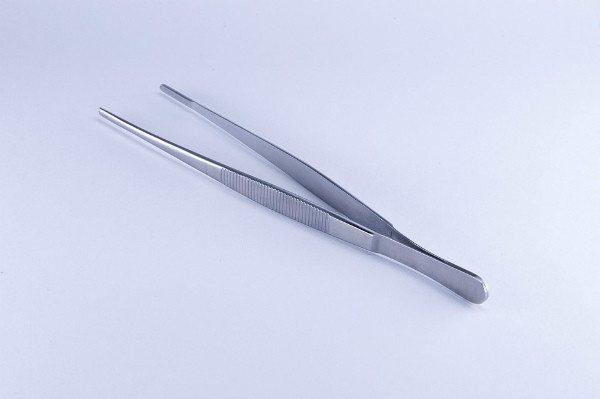

2. Application of thread... If tweezers or forceps are not at hand, then you can resort to using ordinary thread. Make a small loop. Such a "lasso" is thrown over the tick, trying to move it as close to the body as possible. Lightly tighten the loop, fixing the insect. Then they begin to slowly twist the bloodsucker in the opposite direction to the clockwise.
3. Manual method... This is the most dangerous method. Since the tick can serve as a carrier of infection, it is necessary to protect yourself as much as possible from the risk of infection. Therefore, it is recommended to take out the parasite with gloves or protect your fingers with gauze. The insect is grasped with nails right next to the victim's skin and gently twisted. In doing so, it is important not to crush the tick.
By pulling out an insect, many people make a colossal mistake. They just throw out the parasite. In the future, they are very worried whether the tick has been infected. To protect yourself from such experiences, the elongated insect must be saved (it can be in a regular jar with a lid) and taken for research. The analysis will take 1-2 days.
Prophylaxis
The risk group includes cats (cats, kittens) Walking freely on the street or summer cottage. You can protect them with the help of products that you can buy at a pharmacy or prepare yourself:
Sprays are the safest form of protection, but their effect is limited to a short period of time.
Drops: Liquid formulation drips onto the coat. They are absorbed into the skin and the protective effect can last for several months. But the composition of such drops is very toxic.
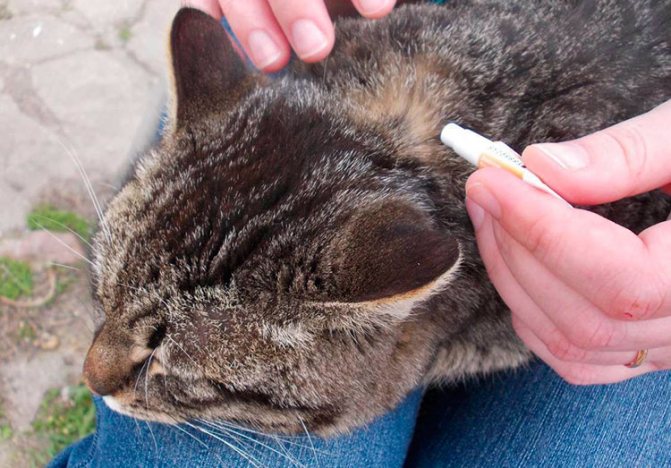

The collar is a great help in protecting your pet. But you need to wear it only when walking outside, as long contact with the skin can cause allergies.
Despite all these measures, only constant attentiveness to the pet will save you from many unpleasant consequences.
During the whole warm season, ticks are active in forests, parks, and meadows. Owners of four-legged friends should know how to remove a tick from a cat and be able to get this parasite painlessly.
Pets that do not leave the premises are also at risk. A person can bring ticks from the street on clothes and bags. Most often, parasites patiently lie in wait for the victim in the grass and thickets of bushes.
What not to do
Wrong actions can aggravate a person's condition and lead to serious consequences. Therefore, it is important to remember what to do is strictly prohibited.
Major mistakes:
- The use of sunflower oil... Do not grease the insect with oil. It is not safe. Under a thin oily layer that does not allow oxygen to penetrate, the parasite will indeed die. But if the tick at the time of its death remained in the body, then before death it will release a dangerous dose of poison into the human body.
- Use of chemistry... It is forbidden to poison the insect with gasoline, varnish and similar substances. Do not use creams, medicinal solutions. This will lead to the injection of a dangerous dose of poison into the human body in the last minutes.
- Tummy pulling... You should never touch the belly of a tick. It comes off very easily.
- Sharp movements... Another mistake is associated with a sharp pulling out of the parasite. To remove the tick from the wound, it must be unscrewed. A sudden movement will provoke the separation of the abdomen from the head of the tick.
- Expansion of the wound... Some try to open the wound and eliminate the bloodsucker. This method is very dangerous for several reasons. If during the removal of the tick it ruptures, then the infection from the body of the insect will instantly enter the human blood. A large wound left after the removal of the parasite serves as a gateway for infection to enter the body.


Why a tick is dangerous for a cat or cat
The tick is a parasite of the arachnid class. It is dangerous to all vertebrates, including cats. The tick grows up to 0.5 cm, but this indicator is typical only for a hungry parasite. A well-fed tick that has drunk blood can grow up to 1.5 cm. Moreover, the color of the insect can also change (from black, brown or brown to red, pink or gray). Outwardly, ticks are similar to spiders: an oval, almost round body, a small head and four pairs of legs.
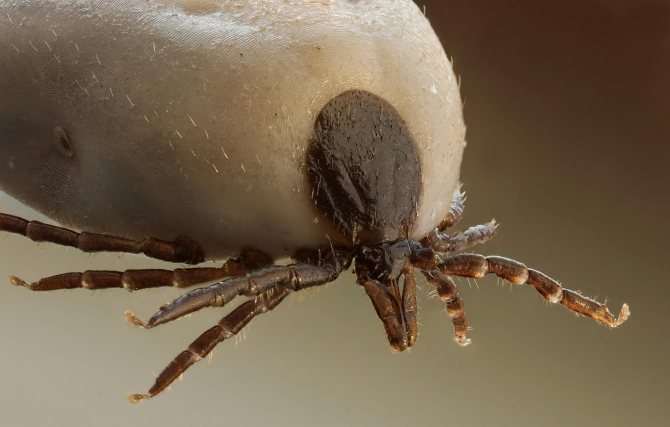

The body of the tick can "swell" depending on the degree of saturation
Gnawing with teeth and hooks (they are on the mouth apparatus) into the victim's skin, the tick is securely fixed. Viscous saliva is distributed around the proboscis, which "sticks" the proboscis so that it is impossible to rip out the parasite with bare hands. Even if the swollen body of the tick can be torn off, its head will still remain in the skin. The “fixation” of the tick on the cat's body lasts 2-3 minutes. Moreover, the longer the parasite is on the skin, the more difficult it is to remove it.
The cat may not show any concern, since in the intervals between the absorption of blood and lymph, the tick injects special enzymes with an anesthetic effect into the wound, which is dangerous. During each such anesthesia, the parasite can penetrate the pathogens of dangerous diseases deep into the tissues of the animal. Ticks are carriers of diseases such as:
- Piroplasmosis (babesiosis) - causes damage to erythrocytes. It is difficult to treat, but without treatment, the cat may die.
- Theileriosis - erythrocytes and tissues of internal organs are affected. The causative agent of the disease gets to Russian cats from abroad. The mortality rate of the disease is high - up to 80%, so it is very important to start treatment quickly.
- Hemobartonellosis (infectious anemia) - causes anemia.Many cats are asymptomatic, but treatment is almost always successful (mortality is about 1%), but a recovered cat has a weakened immune system, which is the danger of anemia.
A particular problem is that veterinarians cannot immediately diagnose the presence of these diseases in a cat. Sometimes there are situations when, for example, piroplasmosis is detected already at later stages.
If the head of the parasite remains in the body
What if the tick burst and the head of the parasite remains in the human body? In this case, you can resort to the following methods:
- Using thread... If a small part of the parasite remains on the surface, then you can use the above loop method.
- Withdrawal with a needle... You will need a regular sewing needle. It is preliminarily disinfected or heated over a fire. Then, with a tip, they gently pry the remaining head of the parasite (according to the principle of removing a splinter) and pull it out of the wound.
Sometimes you can find a recommendation to leave the head in the body. This fragment will decay over time and will be rejected by the human body. To listen to this recommendation or not - everyone decides for himself. But it should be remembered that the head of the tick also contains particles of infection, which all this time (albeit in small quantities) continue to poison the body.
Removal methods
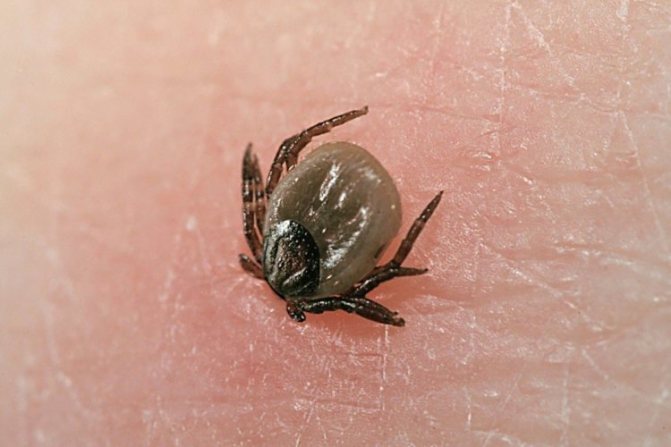

The best option in the event of a tick bite is to go to the hospital. The specialist will quickly and competently carry out the removal procedure and give recommendations for further actions. If this is not possible, then you can remove the insect using an ordinary thread or tweezers. There is also a special device on sale, in the form of a miniature nailer. It costs a penny and when going out into the countryside, it is advisable to buy it in advance.
Tick removal procedure:
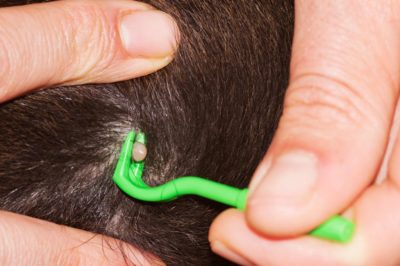

Part the hair at the bite site and press down.- Grab the tick with a clean instrument as close to the proboscis as possible. When using a thread, make a loop, throw it around the hypostome and tighten.
- Pull the insect up, swinging slightly from side to side until it comes off the skin. In this case, care must be taken not to damage the abdomen.
- Treat the wound and hands with any antiseptic - alcohol, iodine, brilliant green or hydrogen peroxide.
- Remember or write down the date of the bite.
If during the procedure the head of the tick came off and remained in the wound, then you should not panic - this happens quite often. The head of the tick is not dangerous and you can remove it like an ordinary splinter with tweezers or pick it out with a needle pre-calcined on fire. You can also treat the remains of the parasite with iodine and after a while the body will reject them by itself.
The problem of ticks is so common that today even special devices are produced to remove them safely. The most popular are Tick Twister and Klinver. They are a kind of hook with a wedge-shaped cut in the middle, with which you can pick up a tick at the very proboscis and carefully remove it. This tool has two main advantages:
- The body of the tick is not compressed. Thanks to this, it is possible to avoid throwing the contents of the intestinal tract of the tick into the wound, which greatly reduces the risk of infection. For example, if a tick is a carrier of borreliosis, then using the Tick Twister or Klinver reduces the likelihood of getting sick by half.
- The tick remains safe and sound. Then he can be taken for analysis in a laboratory in order to obtain reliable data on the presence or absence of infection. Very often this helps to initiate timely and adequate treatment.
If there are no special tools at hand, and the nearest first-aid post is out of reach, a simple thread will help solve the problem. You need to make a loop out of it and wrap it around the tick. After this, the parasite must be slightly raised above the skin and tighten the loop on the proboscis.When the loop is firmly tightened, the tick is gently pulled out with light circular motions.
We offer you to familiarize yourself with Fleas in humans - how to get rid of parasites
This method is quite reliable, especially if the tick has not yet had time to properly launch its tenacious legs into the skin. If this happened, first you need to carefully separate the pest from the body with tweezers, and therefore grab it with a loop. Most likely, you cannot do without helpers here.
If a tick is found on the body, then you need to get it with extreme caution. It is important not to panic, not to try to pull the insect out with trembling hands, because in this case there is a great risk that the head will remain unpull. How to remove a tick from a person according to the rules:
- The first step is to drop oil or alcohol on the parasite and leave it alone for 20 minutes so that it begins to suffocate and begin to crawl out on its own.
- If the tick does not come out on its own, then you should make a loop of thread or take tweezers and gently pick up the parasite. This should be done carefully and slowly so as not to leave the head of the tick in the body.
- After manipulations, the wound must be disinfected. For this, brilliant green or chlorhexidine is well suited.
- The disinfected place must be sealed with a plaster, and the tick put in a jar and together with it go to the doctor.
You should visit the hospital without fail, because there the doctor will introduce a special medicine - immunoglobulin. The doctor will also examine the site of the bite, make sure that the parasite is removed entirely, and if the head of the tick remains, he will take it out. Immunoglobulin with antibodies is usually taken once, but observation by a doctor should be carried out for at least a month.
- convulsions;
- violation of sensitivity;
- paralysis;
- headaches appeared;
- the temperature has risen.
All these signs are harbingers of a serious illness - encephalitis. If this disease is not treated, then death will occur within 7 days.
If the tick was not found
What if the tick was not detected in time and remained in the human body? The situation is very dangerous in its consequences. Doctors say that during the first days after being bitten by an infected parasite, infection usually does not occur. The human body becomes infected on the second or third day. That is why it is important to eliminate the insect as early as possible.


The following recommendations will help to avoid further unpleasant consequences:
- Body examination... After a walk in the forest, they must examine the whole body. The procedure is repeated the next day. By this time, the bite site, which was not identified on the first day, may acquire redness or swelling.
- Human well-being... If, after a few days, and sometimes weeks after a walk in the forest, the state of health sharply deteriorates for no apparent reason, then you should immediately consult a doctor. Possible infection is indicated by the following symptoms:
- hyperthermia (temperature can rise to 39 ° ... 40 ° C);
- redness of the chest, neck, face;
- headache;
- excessive weakness;
- nausea, vomiting;
- muscle pain (worried about the back, neck, limbs, lower back);
- skin rash;
- the appearance of red circles around the bite (characteristic of borreliosis).
The need to examine the body after a walk in the woods is often ignored by those who have been vaccinated. Even having noticed a tick bite, they do not attach any importance to it and do not visit the hospital. It should be remembered: vaccination saves only from tick-borne encephalitis. And the risk of contracting other diseases still remains.
To protect yourself from being bitten, you need to properly prepare for your trip to the forest. It is advisable to choose clothes that protect all areas of the body as much as possible. A headscarf must be tied on the head or a borderless hat is put on. And clothes can be treated with special solutions that scare off blood-sucking parasites.
The best ways to remove a tick and tick parts
You can try to remove parts of the tick yourself, but sometimes it is extremely difficult. If careful actions do not work, you will have to quickly go to the hospital. When it comes to a small child, any independent actions are excluded!
The rules of behavior, if there is a tick proboscis or its head, are as follows:
- Perform all actions wearing thin rubber gloves.
- Do not make a single sudden movement, in any case do not jerk parts of the insect.
- After completing the manipulations, wash your hands.
- Be sure to mark on the calendar when the bite occurred.
Attention: Contrary to some popular advice, it is strictly forbidden to cut out insect particles from the skin, expand the wound and strongly pick out the skin!
There are several options for how to pull out the tick's head when it comes off, as well as retrieving a whole insect:
- Take a sharp sewing needle, ignite it over a fire from a lighter, a match. Next, very carefully pick out the head of the insect. If the head is poorly visible, you need to carefully wipe the skin at the site of the bite with damp gauze, a handkerchief - a clearly visible black dot will immediately appear. After removing the head, you need to wash the suction site of the parasite with soap, dry the skin, wipe the wound with alcohol (brilliant green, hydrogen peroxide, iodine).
- Apply strong forceps (this method is suitable if the head has come off with a part of the body, or the tick sits entirely in the wound). You should carefully twist the pest counterclockwise.
- Twist the loop from the thread, throw it over the tick, tighten, twist it counterclockwise.
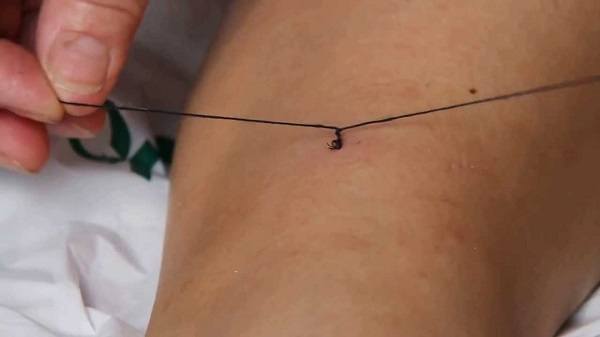

It is almost impossible to remove the proboscis of an insect on your own. Therefore, if it is not possible to remove it from the doctor, it is better to leave a particle in the body, treating it with 5% iodine daily. After a few days, the proboscis will be torn off and removed on its own.
When to be extra careful
Bloodsuckers are especially dangerous for older cats, as well as weakened and low-immune cats. Kittens and pregnant females also fall into the category of difficult tick bites, even if they are not carriers of the infection.
Multiple bites from the parasite are also dangerous to cats. They cause a strong allergic reaction and cause intoxication that must be treated.
From May to June and from August to September, the condition of the animal must be monitored as closely as possible, examining it every evening. If a bloodsucker is found, it is necessary to remove the tick from the cat at home, treat the wound with an antiseptic and visit the veterinarian.
general information
The most dangerous parasites are during the peak of activity, this period begins in May and ends in June. But here it should be borne in mind that in other periods there is also the likelihood of a bite of parasites, they simply become less active, but attack victims until October. The most common and dangerous diseases transmitted by these blood-sucking insects are encephalitis and Lyme disease.
People who live in dangerous areas take a set of actions that minimize the likelihood of attacks and provide protection against infection with dangerous infections. Such actions include regular inspection of clothing and body for parasites, choosing the right clothing that blocks access to the body. There are also routine vaccinations that allow you to cope with an infection that has entered the body.
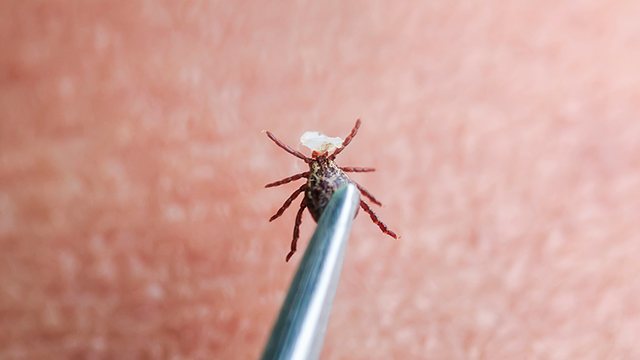

When bitten, the parasite strongly adheres to the skin, and the head deepens under the skin. As it becomes saturated with blood, it significantly increases in size and from above you can see a swollen abdomen that resembles a pea. In this state, it is very difficult to get it out carefully so as not to break it; it is practically impossible to grab the head with the correct means at hand. This leads to the fact that when removed, the abdomen is torn off, and the head remains in the middle of the wound.
Of course, not every tick bite is dangerous, but the likelihood that it will be an infected parasite is always present. It should be borne in mind that the longer it is on the body, the greater the likelihood of infection, therefore, if a bloodsucker is found, it must be removed as soon as possible. And if you consider that the attack takes place in nature, then most often you have to carry out the procedure yourself.
When carrying out the procedure, it is very important to avoid mistakes. In fact, the removal of the parasite is not such a complicated procedure, but in the absence of the necessary information, it will be difficult to carry it out correctly.
Remember not to panic, as it is haste that leads to wrong and dangerous actions.
How to protect yourself from insect attack?
The danger of a tick attack can be minimized by adhering to the following recommendations:


Wear light-colored, smooth fabrics. This will make the parasite easier to spot and more difficult to catch on a smooth surface.- Wear a hat.
- Tuck the outerwear into trousers, and trousers into socks and high shoes.
- Wear long sleeves.
- While walking, keep to the middle of the path, trying not to come close to tall grass and bushes.
Additionally, it is recommended to treat clothing with protective equipment. They are divided into two types of repellents and acaricides. Repellents are used to repel ticks, these include:
- Biban.
- Daffy taiga.
- Raptor.
Acaricides have a detrimental effect on ticks. The following drugs in this group are most effective:
- Reftamid-taiga.
- Anti-mite tornado.
- Herdex anti-mite.
Acaricides should be applied carefully to clothing. If it comes into contact with the skin, the drug may cause poisoning or allergies.
You can also protect yourself from possible infection with the help of vaccination.... This procedure is carried out solely for the purpose of prophylaxis at least 3 weeks before going to the forest; after a bite, the vaccine will not bring any benefit.
If a tick is found, you should not rely on chance, but without fail consult a doctor. Timely treatment will allow you to recover without complications. Ignoring the danger and self-medication will lead to disability, and in the worst case, death.
The animal is not given
If the character of the cat is such that it can neither be immobilized on its own, nor put in a carrier for a trip to a veterinary clinic, there is only one way out: to let everything go by itself. If you do not remove the tick from the cat, usually nothing terrible happens. The parasite either falls off itself, having drunk blood, or the cat brushes it off. In this case, scratching is possible at the site of the bite. But the immune system of cats most often copes with this problem on its own.
Since the arthropod will fall off to the floor of the apartment, one must be prepared for the fact that hordes of larvae will soon fill the house.

